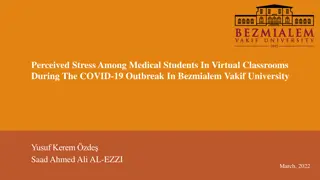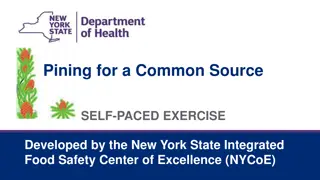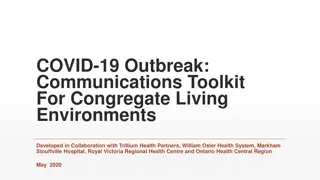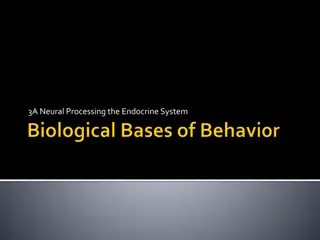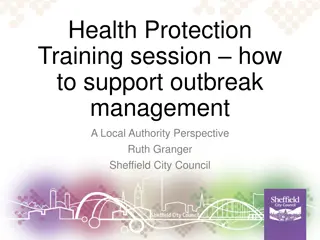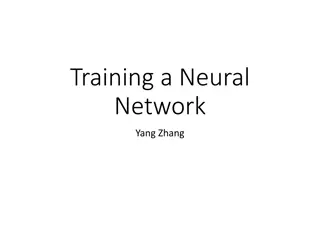Impact of COVID-19 Outbreak on Sustainable Development: A Neural Network Modeling Approach in Hubei Province
This study investigates how the COVID-19 outbreak affects environmental health, economy, and sustainable development using a binary classification model with neural network methods. Factors like weather parameters and confirmed cases were analyzed to understand the impact, emphasizing the importance of environmental sustainability in combating epidemic diseases.
Download Presentation

Please find below an Image/Link to download the presentation.
The content on the website is provided AS IS for your information and personal use only. It may not be sold, licensed, or shared on other websites without obtaining consent from the author.If you encounter any issues during the download, it is possible that the publisher has removed the file from their server.
You are allowed to download the files provided on this website for personal or commercial use, subject to the condition that they are used lawfully. All files are the property of their respective owners.
The content on the website is provided AS IS for your information and personal use only. It may not be sold, licensed, or shared on other websites without obtaining consent from the author.
E N D
Presentation Transcript
ENG384 ASSIGNMENT MISS EJUONEATSE TOSAN DORCAS 17/ENG06/029
ABSTRACT This study is focused on finding ways to handle the outbreak in the whole world and also how it affects the environmental health of individuals and also how it affects the economy. Nowadays, sustainable development is considered a key concept and solution in creating a promising and prosperous future for human societies. Nevertheless, there are some predicted and unpredicted problems that epidemic diseases are real and complex problems. Hence, in this research work, a serious challenge in the sustainable development process was investigated using the classification of confirmed cases of COVID-19 (new version of Coronavirus) as one of the epidemic diseases. Hence, binary classification modeling was used by the group method of data handling (GMDH) type of neural network as one of the artificial intelligence methods. For this purpose, the Hubei province in China was selected as a case study to construct the proposed model, and some important factors, namely maximum, minimum, and average daily temperature, the density of a city, relative humidity, and wind speed, were considered as the input dataset, and the number of confirmed cases was selected as the output dataset for 30 days. The proposed binary classification model provides higher performance capacity in predicting the confirmed cases. In addition, regression analysis has been done and the trend of confirmed cases compared with the fluctuations of daily weather parameters (wind, humidity, and average temperature). The results demonstrated that the relative humidity and maximum daily temperature had the highest impact on the confirmed cases. The relative humidity in the main case study, with an average of 77.9%, affected positively, and maximum daily temperature, with an average of 15.4 C, affected negatively, the confirmed cases.
INTRODUCTION What is covid-19? Coronavirus disease 2019 (COVID-19) is defined as illness caused by a novel coronavirus now called severe acute respiratory syndrome coronavirus 2 (SARS-CoV-2; formerly called 2019-nCoV), which was first identified amid an outbreak of respiratory illness cases in Wuhan City, Hubei Province, China. [1] It was initially reported to the WHO on December 31, 2019. On January 30, 2020, the WHO declared the COVID-19 outbreak a global health emergency.On March 11, 2020, the WHO declared COVID-19 a global pandemic, its first such designation since declaring H1N1 influenza a pandemic in 2009. Illness caused by SARS-CoV-2 was recently termed COVID-19 by the WHO, the new acronym derived from "coronavirus disease 2019. " The name was chosen to avoid stigmatizing the virus's origins in terms of populations, geography, or animal associations Environmental sustainability can be elaborated as a perfect and reliable interaction with the environment to put an end to the exploitation and degradation of natural resources to establish a more positive association with the environment (Sheng 2019). The best and widely used measure for the well-being is Environmental Performance Index (EPI) (A1 Islam et al. 2019). But the disadvantage of this index is that it does not look at the notion of sustainability, in simple terms, it does not have the environmental component specification. In contrast to it, we have useful data gathered from different sources that provides information about the environmental health of countries but not about the human development, such as the EP (u1 Ain et al. 2019).
LITERATURE REVIEW Firstly what is environmental health? Environmental health is the science and practice of preventing human injury and illness and promoting well-being by identifying and evaluating environmental sources and hazardous agents and limiting exposures to hazardous physical, chemical, and biological agents in air, water, soil, food, and other environmental media or settings that may adversely affect human health. Economic development has led to tremendous improvements in people s well-being, but often at the expense of the environment. Industrialization has contributed to pollution of air and water, changing dietary patterns, and shifting patterns of transportation and land use. Exposures to air and water pollutants directly increase disease. Similarly, dietary changes and decreased levels of physical activity, resulting from transportation and other work and lifestyle changes, are contributing to global epidemics of obesity, diabetes, and associated diseases. Globalization and the large geographic scale over which rapid industrialization is occurring make these environmental health problems global health problems. Sustainable development is frequently defined as development that meets the needs of present generations without compromising the ability of future generations to meet their own needs. As evidence of the harm to health and well-being from widespread environmental degradation and global climate change grows communities and governments are placing greater emphasis on assuring that economic development is achieved in a sustainable way.
METHODOLOGY What are the ways to handle this covid-19 so it doesn t affect environmental health and economic sustainability? Firstly, let s know about how covid-19 is shaking the whole world. Forecasts of the economic toll of the COVID-19 pandemic are growing increasingly dire as the scale and severity of the contagion expands. Global supply chains are collapsing, tourism is in free fall, and entire calendars of public events are being canceled. School closures and mass quarantines beyond China, Italy, and other frontline countries are leading to deeply curtailed consumer expenditures. The threat of a protracted global recession is with each passing day becoming ever more probable. Investors are looking to finance ministers and central bankers to further slash interest rates and to offer ironclad promises of generous fiscal stimulus. However, it is becoming apparent that the effectiveness of these strategies is extremely limited and will do little to steady anxious stock markets. Meanwhile, in the real economy, businesses are beginning to feel the tight pinch of dampened demand and preparing to furlough employees. While the challenge of getting the coronavirus outbreak under control is surely ominous, it merits recognizing that from a sustainability standpoint we may have a rare window of opportunity. The challenge will be to lock in the reductions in energy and material utilization that are already occurring and will probably intensify in coming weeks and months. COVID-19 could inadvertently contribute to meaningful progress toward meeting the goals of the Paris Climate Agreement and several of the United Nations Sustainable Development Goals. As we describe below, the coronavirus situation provides, challenging though they may be, several leverage points for opening pathways to a sustainability transition.
METHODOLOGY First, the COVID-19 pandemic is prompting a scaling back of working hours, either to adjust to slower business activity or because parents and caregivers need to remain at home with young children due to school closures. Research suggests that when people have the option to reduce the amount of time devoted to gainful employment, they come to value the benefits of a diminished schedule. Even when conditions improve, there is often disinclination to revert to prior arrangements. Sustainability scientists have suggested that we could shrink our working hours while simultaneously enhancing individual and societal well-being and reducing carbon emissions. Clearly, this possibility is not available to everyone, especially to hourly workers whose wages are tied to a time clock; the challenges of these workers relate to the next point. Second, the public health emergency and economic contraction is an opportunity to broaden experiments involving a universal basic income. During an extended quarantine, hourly workers will face increasingly precarious circumstances. Political pressure to institute a more adequate system of financial security will mount as vulnerable populations struggle to maintain basic needs such as access to housing and nutrition.
METHODOLOGY Third, eruption of community transmission and implementation of lockdowns will disrupt daily commuting patterns and encourage workplaces to shift face-to-face activities to virtual communications platforms. Even partial closures will motivate businesses and other organizations to deploy flextime arrangements that allow employees to design their own schedules and to work remotely. These new routines will prove popular and be difficult to reverse as the crisis recedes. Similarly, it is already becoming apparent that there is a tremendous amount of ultimately unnecessary long-distance travel. There is little reason to suspect that frequent fliers could not eliminate at least some trips without loss to knowledge exchange and professional development. Fourth, while there is currently a rush to buy as consumers stock up on nonperishable supplies, many retailers and consumers will in due course shift to sourcing products from local vendors. This trend will reduce resource throughput and contribute to more sustainable consumption patterns. There is also the prospect that over the longer term such developments might encourage promotion of a new environment and trade agenda that reflects wider concerns about the need to foster less energy- and material-intensive lifestyles.
ANALYSIS OF RESULT In this aspect, we try to present the following 1. Show the most relevant information in graphs, figures, and tables. 2. Include data that may be in the form of pictures, artifacts, notes, and interviews. 3. Clarify unclear points. 4. Present results with a short discussion explaining them at the end. 5. Include the negative results. But we will focus more on 3, 4 and 5 Here are some facts about the covid-19 pandemic As business close to help prevent transmission of COVID-19, financial concerns and job losses are one of the first human impacts of the virus; Not knowing how this pandemic will play out also affects our economic, physical and mental well- being; Despite this fear, businesses and communities in many regions have shown a more altruistic response in the face of crisis actions which could help countries preparing for COVID-19.
ANALYSIS OF RESULT Also to clarify unclear points about the pandemic disease, here are the human consequences of it; In recent weeks, we have seen the significant economic impact of the coronavirus on financial markets and vulnerable industries such as manufacturing, tourism, hospitality and travel. Travel and tourism account for 10% of the global GDP and 50 million jobs are at risk worldwide. Global tourism, travel and hospitality companies closing down affects SMEs globally. This, in turn, affects many people, typically the least well-paid and those self-employed or working in informal environments in the gig economy or in part-time work with zero-hours contracts. Some governments have announced economic measures to safeguard jobs, guarantee wages and support the self- employed, but there is a lack of clarity in many countries about how these measures will be implemented and how people will manage a loss of income in the short-term. Behind these statistics lie the human costs of the pandemic, from the deaths of friends and family to the physical effects of infection and the mental trauma and fear faced by almost everyone. Not knowing how this pandemic will play out affects our economic, physical and mental well-being against a backdrop of a world that, for many, is increasingly anxious, unhappy and lonely.
ANALYSIS OF RESULT Fig2. Confirmed cases of covid-19 worldwide
ANALYSIS OF RESULT What are the essential actions to be taken to try and control the pandemic disease? Health measures must be the first priority for governments, business and society. It is important for businesses to show solidarity and work together to protect staff, local communities and customers, as well as keeping supply chains, manufacturing and logistics working. According to research, my employer is more trusted than the government or media. Daily updates on a company website with input from scientists and experts are recommended to counter politicized messages in the media and from governments. This is particularly true for large companies that have the capacity to do this. Messages about what businesses are doing for their employees and in their communities is also important. Some companies are helping schoolchildren from vulnerable families who can no longer get a school meal; others are providing public health messages about effective hand washing. Even CEOs can show they are working from home and self-isolating, while still being effective in their leadership.
ANALYSIS OF RESULT Also, Following WHO advice, there is a need for the business community to move from general support to specific actions and focus on countries access to critical supplies, including a Community Package of Critical Items (a list of 46 items that all countries need). Of these items, 20 are either not available locally or available stocks are too limited. These missing items fall into four categories: Hygiene: Chlorine, HTH 70%, alcohol based hand rub, liquid soap; Diagnostics: lab screening tests, lab confirmation tests, enzymes, RNA extraction kits; PPE: gowns, scrubs, aprons, sterile gloves, protective goggles, face shields, masks (N95 or FFP2); Case management equipment: oxygen concentrators, oxygen delivery systems, mechanical ventilators. So they should all be made available in countries that lack them. The call for action is for more money, to work with manufacturers to create capacity and to organize purchasing so there is guaranteed access, especially for poorer countries with less resilient public health systems. The concept is to create a global security stockpile of supplies and equipment, an effort that needs: Emergency financing; Access to and increases in manufacturing capacity; Access to national and supplier stockpiles; Warehouses and distribution capacity.
CONCLUSION WHO is also assisting COVID-19 research, bringing together 300 scientists, researchers, national public health experts across the world on COVID-19 in February to assess the current level of knowledge about the new virus, agree on critical research questions that need to be answered urgently and ways to work together to accelerate and fund priority research that can contribute to curtail this outbreak and prepare for future outbreaks. Experts identified key knowledge gaps, and research priorities and shared scientific data on ongoing research, thereby accelerating the generation of critical scientific information to contribute to the control the COVID 19 emergency. WHO is gathering the latest scientific findings and knowledge on coronavirus disease (COVID-19) and compiling it in a database.
Recommendations There s currently no vaccine to prevent coronavirus disease (COVID-19). You can protect yourself and help prevent spreading the virus to others if you: Do Wash your hands regularly for 20 seconds, with soap and water or alcohol-based hand rub Cover your nose and mouth with a disposable tissue or flexed elbow when you cough or sneeze Avoid close contact (1 meter or 3 feet) with people who are unwell Stay home and self-isolate from others in the household if you feel unwell Don't Touch your eyes, nose, or mouth if your hands are not clean












